We originally said we would make it up into Scandinavia and despite getting happily diverted so many times, we have finally arrived!
We left Flensburg after a picnic lunch by the harbour and, quite literally before we knew it, we found ourselves in Denmark. We only realised when we passed a garage with fuel prices written up in kroner and realised all the cars had their headlights on. Germany seems to be the only country in central Europe where headlights are not required during the day. The roads tend to be straight, fairly narrow and without a great deal of traffic. Consequently vehicles speed along overtaking everything in sight until they are flashed by oncoming vehicles. We think this is why driving with dipped headlights is the law. At least it ensures oncoming vehicles can be seen. Not that the Danes drive badly but it's a precaution. On the contrary, the roads in Denmark are generally not too busy and drivers are courteous and tolerant, particularly with pedestrians and cyclists.
Ian's fantasies about Denmark seem to have been borne out. The first shop we noticed after realising we were in Denmark was a sex shop! Actually it was advertised as a sex kiosk but we didn't investigate quite what that meant. Since then we've noticed several more despite this being very much a quiet rural area.
We stopped at Aabenraa, the first real town we reached, to get some money. The first problem was to find somewhere to park free as we had no money for a parking meter! The next was to find a bank machine that would accept our card. The first one rejected it. Apart from once in Hungary this is the only time it has happened. However, the next attempt was more successful. We guestimated a kroner to be about 10p. It turned out to be pretty accurate when we found a newspaper in a café to check exchange rates.
 Our first Danish manhole cover! Aabenraa
Our first Danish manhole cover! AabenraaWe wandered the shopping precinct of Aabenraa and were relieved to discover prices are not as expensive as everyone had led us to believe. They are a little dearer than most of Europe, but no more so than England. Our first adventure was a coffee on a street café. Here Ian infuriated Jill by ordering in Danish and being understood! How does he do it? It shows which of us does all the work if he can find time to keep learning the basics of the language each time we change countries! Incidentally we counted up last night. We have been into fifteen countries so far, and in and out of some of those several times. Actually, Danish sounds more like English than German does. Quite a lot of words sound similar but are written rather differently. We are having less trouble reading things than we expected but it can be very frustrating to know you have only half understood a sign or the caption under a picture. The diacritical situation too, is both dire and critical! Most are new to us, we do not know how to pronounce the vowels and they are difficult to find on our computer.
We reached the little town of Vejen around 4pm. It is a convenient place for us to stop and decide where to go in Denmark from here. The campsite is most peculiar. Despite being the height of the tourist season we are the only people staying on this large and well laid out site! The facilities are clean, there are hot showers, use of a television, free cooking facilities and shady trees. There is also a well stocked shop and a charming manager who speaks perfect English and has lent us an electricity adaptor so we can write our blog. Hopefully not all campsites in Denmark have these electrical fitments or we may have difficulties keeping the fridge running and the computer working. Where is everyone? Even in the winter in France, Spain and Portugal we normally had someone else around. The rules say no noise after 11pm but Ian is threatening to go outside and sing until 11.05pm out of bravado. At least having the place to ourselves we have been able to sit outside cutting each others hair without a queue of hopeful customers forming as it did in Klagenfurt! We now look civilised again.
We've not really had chance to draw any conclusions about the country. People are friendly. Several have spoken to us in English. Meals out, coffees and ice creams do seem expensive but generally foodstuffs are not exorbitant. The countryside so far has been gently undulating with hedges and quite a lot of mixed woodland. It is all rather like England really.
We walked into the town of Vejen this afternoon. The buildings are low level and constructed in brick. They not very exciting and the town centre is just a small modern shopping precinct. There is a museum of art, closed this afternoon but with several very interesting statues set in a grassy area at the front. These all appear to be by Niels Hansen Jacobsen and seem very Scandinavian, full of angst and tragedy. They were very good. Just as good but more light-hearted was his troll in the fountain surrounded by pigs.
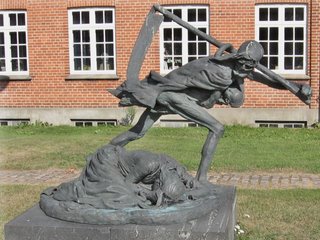 Mother and Death, Niels Hansen Jacobsen (1861-1941), Vejen
Mother and Death, Niels Hansen Jacobsen (1861-1941), VejenBased on a tale by Hans Christian Andersen. Seems more of a Grimm Reaper to us!
 Troll fountain, Niels Hansen Jacobsen (1861-1941), Vejen
Troll fountain, Niels Hansen Jacobsen (1861-1941), VejenRecalling that back in the 1960s when we were library school students, Denmark led the way in library design, we visited the town library. It is a very pleasant building, large for the size of the community with lots of brightly coloured shelves and displays. The overall effect though was that it is now rather dated and crowded. There were numerous cabinets devoted to a display of the largest collection of ceramic and fluffy tortoises we have ever seen, or indeed ever wish to see!
Interesting things turn up unexpectedly. Just as we were deciding we had found the most boring town in Denmark and that was why the campsite was empty, we discovered a side room in the library devoted to the work of Poul la Cour. Of course it was all in Danish so we couldn't fully appreciate it but it seems he was responsible for the first windmill outside the US to be designed to generate electricity – an early form of wind turbine. This was back in 1891. He apparently came from this area of Jutland and his windmill produced sufficient energy to light the local school and surrounding buildings for seven years before it was decided it was too dangerous and was replaced by an improved version. We think he used the electric charge generated by the windmill to separate out oxygen and hydrogen from water and then bring them together again as a highly volatile mixture that could be ignited to produce a brilliant white light. However, maybe we were reading double Dutch rather than Danish!
 Poul la Cour, Vejen
Poul la Cour, Vejen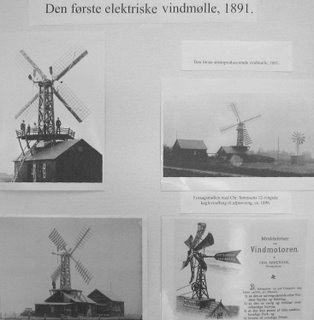 "The first electric windmill", 1891, Vejen
"The first electric windmill", 1891, VejenSee, Danish does look like English!
 "Journal for wind electricity", 1904, Vejen
"Journal for wind electricity", 1904, VejenSo now we must decide what to do tomorrow. Head north up towards Hirtshals or east towards Odense. Having just discovered that not only is there a Hans Christian Andersen museum in Odense, but also one of Elvis Presley memorabilia, it is quite likely we will head for there. All we want to know about the king of fairy tales and the king of pop in one city!
Saturday 5th August 2006, Odense, Fyn, Denmark
Denmark does not yet have the euro. We are gradually getting used to using kroner but some of the coins are quite strange. It goes further than we had feared. In fact, far from burning holes in our pockets, it's the kroner that have the holes.
 The mint with the hole, Denmark
The mint with the hole, DenmarkWe did come to Odense today as we intended. We are staying on a campsite a few kilometres outside of the city but with excellent cycle paths, not only into the town but everywhere we could possible wish to travel in and around the area. It seems that almost every road has its cycle path and it really does make travelling around in towns a pleasure. You feel so safe on a bike here.
 Elaborate manhole cover 1, Odense
Elaborate manhole cover 1, Odense Elaborate manhole cover 2, Odense
Elaborate manhole cover 2, Odense Elaborate manhole cover 3, Odense
Elaborate manhole cover 3, OdenseIt is really quite hot again. Too hot for our liking but it does cool down at night which means we sleep really well. We have to force ourselves to get up around 8am. Not so long ago we were only too glad to get up in the morning as the heat penetrated Modestine's insulated flanks by 6am.
We left our deserted campsite in Vejed and travelled along very quiet roads through pleasant countryside reminiscent of southern England. Even the little towns with their brick houses and low blocks of flats looked very like an English suburban town. It is the country most like ours we have seen anywhere on our travels. Everything is clean, neat and small but not in the least remarkable. There is little we have seen that is worth mentioning as characteristic of the country – except the friendliness of the people who are very open and shame us with their willingness to speak English. It is the first time this has happened to us. In every other country where we are unfamiliar with the language we have had to struggle by as best we may. Here it is almost frustrating not to be able to try.
We crossed from the peninsula of Jutland to the island of Fyn at the delightfully named town of Middlefart. Thinking about Hans Christian Andersen's fairy tales Jill subconsciously hummed the tune of the "Ugly duckling". Thinking about the collection of Elvis Presley memorabilia Ian started singing "Return to sender" in his very own version of Danish! It sounded almost authentic and caused us much amusement.
This afternoon we cycled into Odense and visited the H.C.Andersen museum which incorporates the home in which he was born to poor, working class parents. The museum was the exact opposite of the birth place of Mozart in Salzburg which told the visitor almost nothing about his life. Here we left exhausted after three hours of absorbing countless displays and artefacts giving a fascinating insight into the writer's life and times. It was his fairy tales – over 150 of them – that ensured he is still a household name over 200 years after he was born, but he started his life as an actor, wrote a number of novels and poems and in later years became a great traveller. It is this aspect of his writing that we are now interested to follow up when we return home. During his lifetime he travelled outside of Denmark for a total of nine years and kept detailed travel accounts which he later published. Although his journeys were mainly within Europe he did travel to Africa and Asia as well.
 Hans Christian Andersen (1805- 1875), Odense
Hans Christian Andersen (1805- 1875), OdenseNowadays his writings have been translated and published all over the world and the museum has a library of thousands of the editions and translations which we were able to visit.
 Library, Hans Christian Andersen museum, Odense
Library, Hans Christian Andersen museum, OdenseAndersen never married though he proposed to, and was rejected by, the opera singer Jenny Lind, known as the Swedish Nightingale. His fairy tale "The Nightingale" is widely accepted as having been written with her in mind. He appears to have been a large and awkward character but was also artistically gifted. Amongst the unlikely exhibits we saw were incredibly delicate patterns and pictures made by folding and cutting paper. The scissors he used for this and the size of his hands make it the more amazing that he could produce such delicate works. He suffered throughout his life from tooth ache and eventually had them all removed and replaced by dentures.
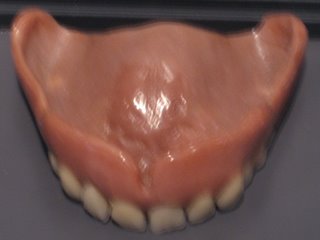 Once upon a time there was a kind tooth fairy who brought a present to a Danish story teller, Odense
Once upon a time there was a kind tooth fairy who brought a present to a Danish story teller, OdenseToday the house where he was born, just two weeks after his parents married, is part of a little area of beautiful, single-story cottages with roses at the door and bright hollyhocks in front of the windows. In 1805 though they were wretched hovels at the poor end of the town where several families, each with numerous children who rarely made it beyond the age of five, would be crammed in without water or sanitation. His father was a shoe maker who died early and his mother an alcoholic washer woman. That he achieved such acclaim as probably Denmark's leading writer, and came to mix with the higher echelons of society is truly quite remarkable.
 Birthplace of Hans Christian Andersen, Denmark
Birthplace of Hans Christian Andersen, Denmark Houses around the Hans Christian Andersen museum, Denmark
Houses around the Hans Christian Andersen museum, DenmarkIn the end we just had to give up reading everything and rush through the rest of the exhibition before the museum closed. We were really fortunate that all the texts were displayed in English as well as Danish. In that respect we are definitely at an advantage over many other international travellers visiting Europe's cultural hotspots.
Sunday 6th August 2006, Odense, Fyn, Denmark
Jill's gutted! Having been lured all the way across to Odense by the prospect of seeing the only Elvis museum outside of the USA, we now find the museum moved to the north of Denmark five years ago! Our German guidebook is dated 2005 so they are publishing out of date information.
This morning we cycled into the town again. Being Sunday in Denmark everywhere was just about as exciting as you might expect to find it. The streets seemed quite deserted. However, having dutifully waited for the traffic lights on the cycle track to turn green we were rewarded with a flashing sign saying we were the 742 and 743 cycles to pass through this morning! It was only 9.30am so that gives an idea of just how many bikes there are zooming around Danish cities.
On our way not to see the Elvis museum we called off to explore the museum of printing where there were supposed to be workshops and demonstrations. Once inside it became obvious that not only were there no demos or workshops but most of the museum was closed for refurbishment. What we saw though was enjoyable and there was a large library of books on the history of printing. Ian's ego took a knock however when we couldn't find any of his publications on the shelves!
 Handpress, Museum of the Press, Odense
Handpress, Museum of the Press, Odense Binder's workshop, Museum of the Press, Odense
Binder's workshop, Museum of the Press, Odense Newspaper rotary press, Museum of the Press, Odense
Newspaper rotary press, Museum of the Press, OdenseThere were other exhibitions on other floors of the converted textile warehouse, but they were all rather strange. Excitement in Denmark consists of sitting in a darkened room watching a looped film of a car being washed, over and over again, all day long! We took a photo of the screen for the blog but it is even too boring for that!
Next door was Tidens Samling, a small museum of twentieth century lifestyles in Denmark, home of innovative furniture design. It is incredible just how dated everything looked! There was a special exhibition on the home in the 1980s. As most of our home was set up in the 1970s we expected everything to look more modern. Maybe we just don't notice our own home furnishings, or perhaps we just have timeless designs, but the room sets here looked far more dated with plastic chairs, Scandinavian teak furniture, posters of Che Guevara, enamelled teapots and platform-soled shoes. In one of the back rooms, out of sight of the volunteer staff who were chatting away in incomprehensible Danish to each other, we took a few items off the shelves and tried them on.
 1960s Danish chic, Tidens Samling, Odense
1960s Danish chic, Tidens Samling, Odense 1960s Danish chick, Tidens Samling, Odense
1960s Danish chick, Tidens Samling, Odense  Straight from Monty Python, Tidens Samling, Odense
Straight from Monty Python, Tidens Samling, Odense On our way out we were asked to sign the visitors' book. It was a ploy for the ladies to use their English. They were really nice and friendly and quite astonished when we said we were off to the Elvis museum. They had never heard of it but when we showed them the evidence in our guide book they determined to go next week.
We headed off on our bikes, miles out of town and ended up on a run-down industrial estate with nothing but a bowling alley open. We demanded to see the Elvis memorabilia waving our map and guide book as evidence when they tried to deny its existence.
Distraught with grief we returned to the town centre and found an internet place where we stretched our brains working out onscreen instructions in Danish. At least the keyboards are easier than in Hungary.
Seeing restaurant prices we decided instead to buy a savoury croissant each in a little supermarket. That cost us over £4 together with one coffee to share. We could have had a banquet for that in Hungary and even Germany was quite cheap. Later we brought half a loaf of bread and a bun. Together they cost about £3.50. This campsite for two nights is nearly £40 and electricity to run the computer and fridge costs us £2.50 a night. (This isn't really a moan, it's a way of recording costs for when we compare prices in the future.)
We returned to the museum of the 20th century to warn the ladies working there not to waste their time exploring the industrial hinterland of Odense seeking out their pop idol. They were as upset as we were and immediately started a silver surfers search on Google, triumphantly informing us that the Elvis collection was alive and well and living in Randers. We will continue our search there as we travel north.
Hans Christian Andersen completely dominates the town. There are numerous bronze statues of him in the streets and parks, roads are named after him and copies of his paper cuts have been cast in metal and adorn almost every corner of the city. He is to Odense what Goethe and Schiller are to Weimar, Van Gogh is to Arles and Mozart to Salzburg. It is quite fascinating arriving as an outsider, but living in the town and being confronted with the same icon day after day must become both monotonous and irritating. Perhaps it is not altogether surprising the town council decided Elvis was a cultural distraction!
 Where Hans Christian Andersen spent his childhood, Odense
Where Hans Christian Andersen spent his childhood, Odense Paper cut by Hans Christian Andersen cast in metal, Odense
Paper cut by Hans Christian Andersen cast in metal, OdenseApart from the composer Carl Nielsen, who hardly gets a look in beside Andersen, there is one other figure of note in Odense. That is King Knut, later St. Knut. The cathedral is dedicated to him and his tomb and mortal remains lie in the crypt there. Jill was delighted to discover the original location of his tomb suffered from rising damp. Ian though, with his superior knowledge, put the dampers on Jill, by telling her he was not the King Canute who tried to turn back the sea but a later one. It's been a bad day for Jill's daydreams with neither Knut nor Elvis turning up trumps.
This king Knut shuffled off his mortal coil in 1086 and was canonised around 1100. His tomb is still intact in the crypt and so are his bones. It's not everyday you see so much of a saint. His thigh bone is still connected to his knee bone and his neck bone to his head bone! There are a good few in between as well. He was apparently murdered in the church. Sounds a popular pastime around that date. When was it Thomas à Becket met a similar fate?
However, I digress – one has to find amusement where one can in a country as lacking in excitement as Denmark. The cathedral is 14th century, brick-built gothic, its appearance belying its age. Inside it is very pleasant with a beautiful carved and gilded altar screen dating from 1523.
 Cathedral of St. Knut seen from the Hans Christian Andersen Gardens, Odense
Cathedral of St. Knut seen from the Hans Christian Andersen Gardens, Odense 16th century altar screen by Klaus Berg, Cathedral, Odense
16th century altar screen by Klaus Berg, Cathedral, Odense King Knut's mortal remains, Cathedral, Odense
King Knut's mortal remains, Cathedral, OdensePhotographed through a glass case
It has been hot today and we were weary so decided we had seen most of what Odense could offer – not an enormous amount for its size – and set off to find our bikes, chained to some railings somewhere in the town. On the way we discovered a young trio of actors and an audience of kids and parents enjoying street theatre. We joined the crowd. Obviously the language was quite incomprehensible to us but fascinating to listen to. The laughter and enjoyment of the crowd was quite infectious and we laughed and clapped with the best of them despite having little idea what it was all about.
 Street theatre, Odense
Street theatre, OdenseWe cycled back to the campsite and relaxed in the evening sun as we sorted out the images for tonight's blog.
Monday 7th August 2006, Randers, Jutland, Denmark
We are hot on the trail of Elvis! Just six kilometres from here his sequined white suits and 1,499 other items of memorabilia await us tomorrow morning! How could we have ever thought Denmark lacked sparkle!
The Landscape of Denmark, as in Friesland, is freckled with those tall, white, wind turbines. No matter which direction you look, you are almost guaranteed to see a few rotating their three limbs. Despite fears about ruining the environment we find they are quite acceptable and sometimes seem to add a certain charm to a view. It has never occurred to us to wonder how they came to be there until we encountered a low loader lorry today bringing a replacement arm for one of these silent giants. It proved quite incapable of navigating the roundabout and effectively blocked the traffic in all directions for several minutes as it manoeuvred around.
 Lorry turning left with a wing from a wind turbine.
Lorry turning left with a wing from a wind turbine.We left Odense this morning and drove to Jelling where Ian was eager to see a couple of tumuli and stones carved with runic inscriptions. we spent a very interesting couple of hours. The interpretation centre and museum even had a travelling exhibition on the Bayeux Tapestry. As we'd already seen the original we concentrated instead on climbing the high tumulus of King Gorm the Old who died in 958. He seems to have always been old and was the first true king of one of the oldest kingdoms in Europe according to the information leaflet. Gorm the Old had a son – presumably called Gorm Oldsen or possibly Gorm the Young. (Ian has just informed me he was called Harald Bluetooth and once his father died he became quite gormless!)
Nearby stand the runic stones incised on one side with an interlaced knotwork design very similar to the Celtic designs. On the back of the large granite slab was a runic inscription in those sharp, angular letters. Originally it was believed the stones would have been brightly painted. Similar designs, texts and patterns appear in the Lindisfarne Gospel, produced on the island just of the Northumberland coast a couple of hundred years earlier.
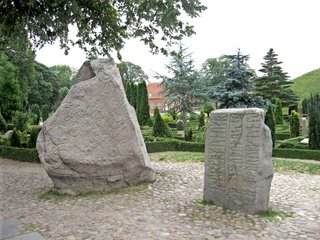 Runic stones in the churchyard at Jelling
Runic stones in the churchyard at Jelling Runic stone in the churchyard at Jelling
Runic stone in the churchyard at Jelling Modern runestone in the village of Jelling showing how they would have been coloured
Modern runestone in the village of Jelling showing how they would have been colouredThe stones stand in the churchyard. The church is much more recent dating from 1811 but is on the site of the simple building erected by Harald Bluetooth after his conversion to Christianity. The present church is very different from those we have seen elsewhere in Europe, being a simple brick building, whitewashed inside and out with modern Scandinavian light fitments and very attractive stained glass windows. A ship hangs from the plain wooded roof and the polished granite floor is incised to resemble waves.
 Interior of the church at Jelling
Interior of the church at JellingOutside the cemetery was neatly laid out, each grave assigned its own plot. From the top of the Tumulus of Gorm the Old it looked more like a little campsite than a cemetery! Wandering around it later we found it very attractive with its tiny neatly trimmed hedges around the graves each of which was marked with a rounded granite boulder, possibly weathered by the ice age. Each had its own inscription and it was here that we fully realised why Denmark seems to lack sparkle. Everything is the same! Even the names are the same. Here we found, crowded close together, Hans Hansen, Christian Christiansen, Anders Andersen, Niels Nielsen, Erik Eriksen, Jesper Jespersen and Jørgen Jørgensen. Honest! Elsewhere there are variants – Erik Niels Andersen, Niels Anders Eriksen and even Niels Erik Nielsen! That’s just about how original and exciting it gets!
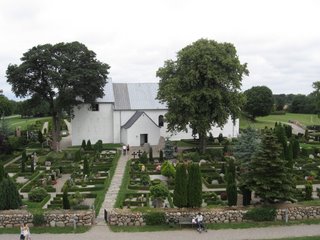 Church and graveyard seen from the tumulus of Gorm the Old at Jelling
Church and graveyard seen from the tumulus of Gorm the Old at Jelling Gravestone in the churchyard at Jelling
Gravestone in the churchyard at JellingSo we left Jelling behind and continued through a mild mizzling rain to Silkeborg. Here we found the streets rather dull. The town only really developed around 1846 so it has little of historical merit and the main town seems little more than an uninspiring but functional shopping precinct.
 Excitement on the streets of Silkeborg
Excitement on the streets of SilkeborgThe main square is a little better but we were regretting wasting our time stopping when we discovered an old paper mill down by the river. The afternoon was transformed! The guide and demonstrator spoke excellent English so we were able to fully appreciate our visit and they too seemed to enjoy the chance to speak in English to visitors who were familiar with the techniques of papermaking. The original paper mill was a main cause of the town's development and became one of the leading Danish rag paper manufacturers. They used to make the paper for the Danish banknotes and indeed for many of the Asian and African countries. Today most paper is machine produced so now this small industry is really just a museum. We even tried our hand at paper making. There was a small exhibition on watermarks and how they are moulded or stitched to the mould with copper wire.
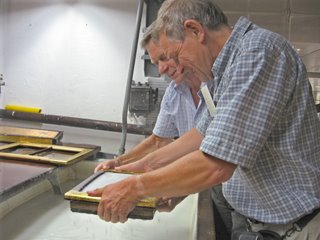 Ian makes a sheet of paper, Bikuben Paper Museum, Silkeborg
Ian makes a sheet of paper, Bikuben Paper Museum, Silkeborg Equipment for making embossed watermarks, Bikuben Paper Museum, Silkeborg
Equipment for making embossed watermarks, Bikuben Paper Museum, Silkeborg Hollander – used for making pulp from cut-up rags, Bikuben Paper Museum, Silkeborg
Hollander – used for making pulp from cut-up rags, Bikuben Paper Museum, SilkeborgSo absorbed were we that the afternoon sped by. Nearby is the museum, housed in the oldest building in Silkeborg, dating from 1767. Here we were told was Tollund Man, and indeed Tollund Woman. We hurried across to see them but the museum was on the point of closing as we arrived. We remember seeing a programme several years ago on these two bodies, dating from about 350BC. They were discovered, perfectly preserved in a local peat bog. They had both been hanged. Their clothing, bodies, even the rope that killed them were complete. Similar bodies have been found in Britain, including Lindow Man and another in Risdale Moss near Manchester. It would have been interesting to see them but certainly papermaking was a less macabre activity.
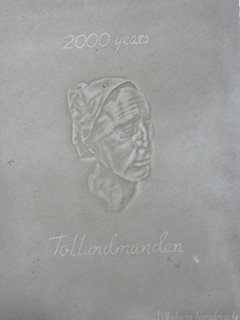 Handmade paper showing the head of Tollund Man as a watermark, Bikuben Paper Museum, Silkeborg
Handmade paper showing the head of Tollund Man as a watermark, Bikuben Paper Museum, SilkeborgSo we drove on northwards towards Randers along quiet, almost deserted straight roads through an undulating landscape with grassland and woodland to either side. It was very pleasant but not at all remarkable. That is how Denmark strikes us really. Everything is nice – an unimaginative word for a country that seems rather lacking in individuality. Hopefully we will gradually discover what makes it tick over the next week or so but just for now we cannot get under its skin. Everyone is so friendly and helpful, everywhere is clean, neat, orderly and rather dull.
As we drove along a stretch of straight quiet road through woodland we were overtaken. As the driver moved in again a large deer leapt out from the roadside directly into his path. The driver braked so violently a tyre burst and scattered across the road. The deer was hit full on and thrown right out of sight into the undergrowth on the far side of the road. It would have been killed instantly. We braked and mercifully avoided any contact with the car in front. The driver must have been so shocked by the incident. We stopped of course but as we didn't speak the language it was doubtful how much use we could be. Fortunately a car behind us also stopped and helped the driver as they went off to find the carcass. What does one do with a large dead deer? Does it have to be reported? Do you leave it there or take it home to fill the freezer? We just hope we personally never need to find out. They are a hazard though. It almost happened to us near Rohrbach a few years back. Deer may run from man but they have a death wish when it comes to motor vehicles.
We found the campsite in an open glade in a pine forest. This evening Ian has amused himself with the giant-size Lego bricks by the children's sand pit. One year after retirement and he has regressed to that stage already!
 Ian plays with Lego bricks in Denmark
Ian plays with Lego bricks in Denmark